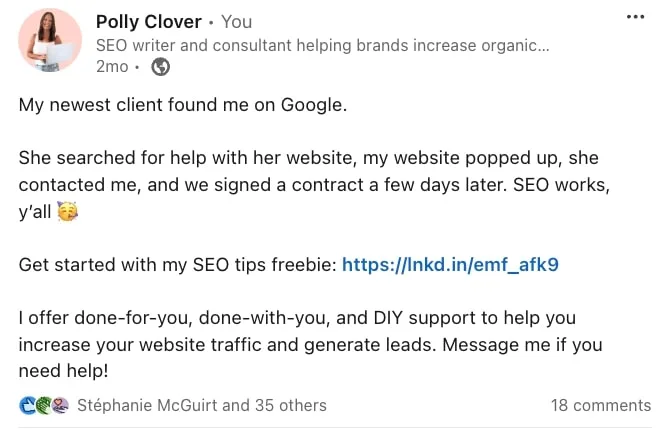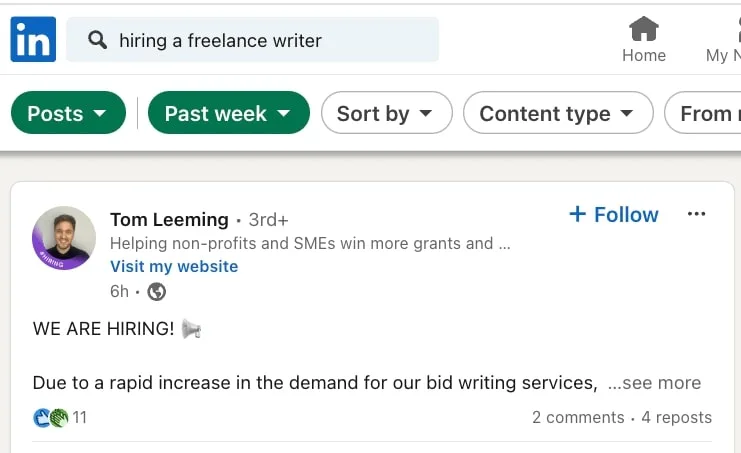
With over 66 million monthly active users on LinkedIn, many of which hire freelancers, it’s an excellent platform for landing clients and growing your brand. But how does LinkedIn success for freelancers work? In this article, we’ll discuss our best tips and how you can find freelance work on LinkedIn.
After years of freelancing, I started actively using LinkedIn about a year ago. It’s been great for my business, as it’s helped me connect with potential clients, get work, and build relationships with other freelancers.
Let’s explore how you can use LinkedIn to grow your freelance business.
Read more: 10 Essential Freelancer Tips for Beginners
Is LinkedIn good for freelancers?
As a social media platform created for people in business, LinkedIn is an excellent platform for freelancers. Not only are six people hired on LinkedIn every second, but 88% of organisations report hiring contingent workers such as freelancers. While there are many ways to find freelance clients, LinkedIn has many great opportunities.
LinkedIn for Freelancers: Best Tips for Success
To successfully use LinkedIn to grow your freelance business, you must stand out, grow your audience, and make meaningful connections.
Create a Stand-Out Profile
When I began actively using LinkedIn in 2023, I quickly realised how much competition there was. However, knowing so many companies hire independent contractors, I knew I could be successful by setting myself apart from other freelancers.
With over 900 million LinkedIn members and 48% of the workforce being freelancers, your profile must help you stand out.
Like I’ve done on my LinkedIn profile, you can do the following to create a stand-out profile:
- Identify your ideal client and exactly how you can help them
- Create a Headline and About section that explains the above and incorporates a touch of your personality
- Include how you’ve helped previous clients and testimonials in your About section
- List previous freelance jobs you’ve had in your Experience section
- Share any relevant details in your Education, Volunteer, and Skills sections
- Connect with anyone you’ve worked with in any capacity before and ask them to write a LinkedIn recommendation for you
- Add an image of yourself for your profile photo and an informative background photo
Below, you’ll see how a quick glance at my LinkedIn profile shows my ideal clients what I do, who I help, a bit about my experience, and what they can expect if they work with me:

Write Effective Posts
Creating content for LinkedIn is what holds many freelancers back. When I began using LinkedIn, I spent a few months mostly browsing other freelancers’ profiles. While this can spark ideas, you want to avoid staying stuck here so long that you don’t actively use the platform to grow your business.
Consider starting with one or two weekly posts and then building up to more, depending on a posting schedule that makes sense for you. Three to five posts per week is ideal if you want to reach new people and show up as a thought leader in your niche. This is how you stand out to potential clients.
Here’s what you might share in your LinkedIn posts:
- Personal experiences your target market might find interesting or relate to
- Information about your offers (make sure you include a unique, personal touch)
- A review from one of your clients with details on how you helped them
- Results you helped a client achieve
At the end of every post, you should include a call to action that directs readers to engage with your post or click a link – similar to what you see on this post:

Grow Your Network
Your network should naturally grow after a few months of consistently posting on LinkedIn. However, there are strategies you can use to actively increase your following and develop relationships so you can build your brand and find potential clients.
The key to success is authentically growing your network by developing meaningful relationships with other LinkedIn users. To do this, it’s best to:
- Connect with people you personally know, including those you’ve worked with in the past
- Follow company pages and people you might be interested in working with
- Send a brief, personalised message when you connect with people
- Avoid sending pitches regarding working together as soon as you connect with someone
Engage with Others
To be successful on LinkedIn, you must engage with other users outside of only following and connecting with others. This helps you develop meaningful connections and find work opportunities.
To engage with other LinkedIn users:
- Share thoughtful comments on posts you genuinely resonate with
- Reply to comments people make on your posts
- Include a personalised message when you send a connection request
How to Find Freelance Work on LinkedIn
LinkedIn won’t bring you an influx of clients overnight, especially if you’re new to the platform. Like with any marketing strategy, it takes time to gain traction.
However, you can find freelance work on LinkedIn over time with the following techniques.
Write Posts for Your Ideal Clients
The majority of your LinkedIn posts should relate to your target market. Whether you’re sharing a personal story or a more technical post, put yourself in your ideal client’s shoes when writing it.
Follow these steps to write posts for potential clients:
- Let them know in the first line you’re speaking to them
- Use the words “you” and “we” to help them connect with the content
- At the end of your post, include a call to action to engage them
While most of your posts should follow the format above, writing the occasional fun post without a strategy is okay. LinkedIn is a social media, so making connections doesn’t always have to be about business. For example, you might share an interesting story about your weekend and ask readers at the end of the post how their weekend was. You can also include pictures in your posts.
Read more: 10 Ways to Promote Yourself on Twitter (+ Find Freelance Work)
Do Outreach
A common way to find freelance work on LinkedIn is through outreach, commonly known as cold or warm pitching. Cold pitching is reaching out to a prospect you haven’t had contact with before, while warm pitching is reaching out to a previous contact or communicating with someone before pitching your services to them.
Two ways to message potential clients on LinkedIn directly are connection requests and InMail. With a connection request, you ask to connect with someone, and you can include a short message. With InMail, you can send a longer message to anyone, whether or not you’re connected or sending a connection request.
Connection requests with a personalised message usually seem more natural and less salesly than InMail. However, LinkedIn suggests only connecting with those you personally know, so it’s best to have some prior interaction. You can follow a person to interact with their posts before sending a connection request.
I recommend only reaching out to people you genuinely want to work with and those you’ve had some contact with, even if it’s an interaction on a post. I find that developing relationships through post-engagement and casual chatting is a better use of time than sending cold pitches.
When you’re ready to reach out to someone you want to work with, you might send a friendly, personalised message like the one below:
“Hi [name],
I loved your post about X! [share a quick sentence about why you appreciated the post]
PS If you’re ever looking for help with [whatever service you offer], I’d love to work with you!”
Read more: Freelance Writer Pitching Guide (+ Mistakes to Avoid)
Use the Search Function
One of my favourite LinkedIn hacks for freelancers is using the search function to find opportunities people post about on their profiles.
If you’re currently in need of work, go to the search feature at the top, left-hand side of the LinkedIn browser, and type in “hiring a freelance writer/designer/your job” as you see below. Then, you can use the filters to choose “posts” and sort by the latest to see recent call-outs for freelancers.

I recommend this method over looking at freelance positions under job listings, as these are usually highly competitive and get hundreds of responses within hours.
When you see feed posts hiring for freelancers, carefully read and follow the directions. Usually, the person will want you to follow a link to an application, send an email, or message them. Regardless of the method, you can also send a connection request and a short, friendly message letting them know you’re interested and hope to chat more about the opportunity.
Be Consistent and Patient
To find freelance work on LinkedIn, and with any strategy, consistency and patience are key. Landing clients requires showing up regularly, growing your network, and developing relationships.
I’ve been active on LinkedIn almost every workday for about a year. I spend about 30 minutes per day posting and engaging with others. To avoid getting too consumed by LinkedIn, I only use it on my computer and don’t have the app on my phone.
Here are some tips that can help you be consistent and patient with LinkedIn:
- Identify target audience and potential post topics
- When post ideas come to you, have a place to jot them down, like a Google Doc or the notes app on your phone
- Choose a posting schedule you can realistically commit to (e.g., 3 or 5 days per week)
- Decide when you’ll spend time posting and engaging on LinkedIn
- Try not to get discouraged if you don’t see immediate results, and understand it takes time
- Enjoy using LinkedIn to make connections with other freelancers and potential clients
We hope you found this article about LinkedIn success for freelancers helpful. For more on growing your freelance business, check out these articles:

